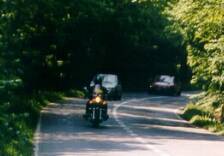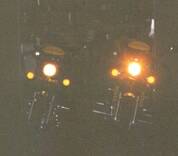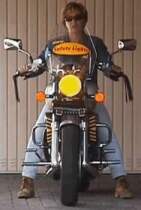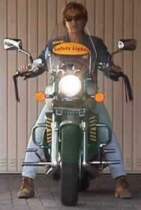



Safety Lights has developed several product for your safety. With these products your conspicuity is much better. Also you can see more with our products. Al products use your existing lamps. We also sell fully automatic battery chargers. Click here for the "Battery chargers".
Al our products work with 12 Volt DC and are suited for all negative ground systems. Every motorbike meets these conditions. With cars we know that Suzuki has often positive ground. When negative ground the switches are in the positive wires, therefore no voltage is on the lamps when he switch is off. Positive ground is the other way around. We are developing 24VDC versions. We can deliver 24VDC versions on demand. Look at some pictures to see the difference.
If you do not want to be extra conspicuous every time you brake, mount the blue wire of the module only on the foot braking pedal with a diode behind it (3 amps is sufficient) so the module only is activated by the hand brake lever. In case of a emergency you will automatically use your foot too. See scheme 9 at Tips&Tricks.
| Safety Lights (0) | Safety Lights (1) | Safety Lights basic | |
| Running-Lights, dipped burning | 6 Watt | 0-9 Watt adjustable | 0-9 Watt adjustable |
| Extra conspicuous when necessary | not or continuous | adjustable, 0 to continuous | adjustable, 0 to continuous |
| Hazard, familiar on/off | no | yes | yes |
| Improved hazard warning lights | no | no | yes |
| Hazard stays on when contact is off, battery watch | no | yes | no |
| Power consumption when standing still, in rest | no | yes | no |
| Suitable for trailer | no, max. 4x21W | yes, max. 8x21W | yes, max. 220W |
| Operated with brake switch | no | yes | yes |
| Safety Headlights | Safety Duplo Headlights | |
| Dip high beam, 25% | yes | yes |
| Dip low beam (+ high beam) | no | 0; 30; 50; 70% |
| Extra conspicuous when necessary | no | Adjustable, 0 to continuous |
| Adjustable automatic signaling time | no | 0 to continuous |
| Continuous signaling or pulsating | no | yes |
| Quantity of 55W bulbs (capacity) | 2 | 4 (2 each outlet) |
| Operated with passing switch | no | yes |
The rule is not to use driving beam (low beam) at all. Only in case of a-symmetrical high beam lamps you have to use 50% low beam (driving beam) next to the 25% high beam. In other words: is your high beam symmetrical than do not use low beam (driving beam). Below are several examples of headlights configurations.
| Low beam (driving beam) | High beam | |
| 1 Duplo lamp (H4) (choppers, BMW, older bikes, PC) | Off, at 0 | at 25% (standard) |
| 2 duplo lampen (2xH4) (prevrious Ninja's, Pan European) | Off, at 0 | at 25% (standard) |
| 1 duplo (t.b.v. groot) + 1x niet H4 (dim) (older bikes) | 50% | at 25% (standard) |
| 2 lampen niet H4 (H1 H3 H7 etc.) (modern sport bikes) | 50% | at 25% (standard) |
Below you can read more about these products.
To improve the illumination even more we have developed a double headlight dimmer. You will have 25% high beam, like the Headlights, there is also an outlet for the driving beam or low beam and the option of automatic signaling. You can also use the extra conspicuity when acquired. You signal not only with the high beam but also with the low beam (driving beam), this is much more conspicuous. Because of this the high beam does not have to burn full but can be dipped which makes this automatic signaling less (not) blinding for the others. The pattern for signaling is long, short, long etc. On the long flash the low beam is brighter and on the short flash the high beam is brighter which generates even more movement. This is very conspicuous but not blinding like normal signaling. Note, when you cannot turn of your low beam you have to disconnect this. Without adding a switch you will only have 70% of your low beam at your convenience. In practice you will not need more than 50% of your low beam in combination with 25% high beam because you illuminate much more efficient and can see more with 50% low beam next to 25% high beam.
In fact this is a double Headlights with an outlet for low beam (driving beam) and another outlet for high beam. The low beam gets 3 (4) extra levels, namely: (off); 30; 50 or 70%. You operate, switch to another level with a short click on the passing light (signaling button), so with a pulse on the high beam. There is also the possibility to let the module signal automatically for an adjustable period. You operate this with 2 short clicks, short after another on the passing light. In fact the electronics take over after two operating clicks on the passing switch, according a adjustable time (menu 14). With 3 short clicks the module keeps signaling, for example in a traffic jam, until you turn this off with a click that is slightly longer (0.7 sec). If you do not have a passing button you can mount our horn-signal module.
Further more this module has the opportunity to be very conspicuous when needed. You can connect a wire with your brake switch so you track attention when you brake. You can adjust the maximal time of flashing with menu 17 (reachable with passing switch) and according the same special pattern as on the Safety Lights (on the indicators). This is operated analogous as the Safety Lights. Safety Lights is operated with the brake light and Duplo Headlights is operated with Passing light.
If you have 4 headlights, or two with duplo bulbs, your car for example, than you should connect the red wire directly to the battery and use a 20 Amp fuse. U can order the fuse directly with the Duplo Headlights.
This module makes your horn switch also for signaling (passing light). Your horn switch simultaneously activates this module and your high beam. Your horn will only sound after aprox 0.5 seconds. This way you can signal fast and operate the Duplo Headlights module without blowing your horn.
Safety Lights (also called Safety Running and Braking Lights, for short SRB) is our own invention and it lets your indicators burn dipped. At the same time not interfering with their normal operation. This is very important while research has shown that patterns with 2 light stains is the most conspicuous. Even children notice these patterns better than any other pattern and in a reflex the eyes are fixed upon this pattern. The reason for this is that this pattern looks like the eyes of a predator. This seams fully logically because we would not have existed if our forefathers where not trained in spotting this! However this is not the only safety feature Safety Lights has. When you are not being seen, or something else is not going oke, you will brake. At that time you can let your indicators flash in a patented pattern which will make you be noticed after all! This looks a little like the French cars of nowadays, they turn on the hazard when making an emergency stop. Whit this function you also have a braking signal on the front side, which is very useful in a traffic jam, on crossings etc. What this feature also does is that, when brake is applied, everybody is with his mind at the traffic! When the attention is with the traffic no accidents will happen! Also if weather is poor, these orange light spots are very good conspicuous, very good contrast. Read this site also if you want to know what is the best way to be noticed.
This module has several improved hazard functions. It has more conspicuous hazard, a very little power consuming hazard, S.O.S. function etc. Normal hazard is much less conspicuous because it is very slow.
How this system works: An electronic signal is being put on the existing loom (wires). When direction is activated the system automatically shuts itself down. When you deactivate your indicators the system automatically turns on again.
This last version of our product is improved on several points and also lower priced. The threshold's are removed so you do not have to adjust this. Instead an additional wire is added (brown) which must be connected to a wire that is powered by contact. The power consumption after the key is removed is therefore removed. After the key is removed the hazard is also shut down. You can mount a switch and diode to overcome this when you want to leave hazard on!
The most efficient sequence is already programmed. 1 short application (tick) off the brake (shorter than real braking, like double-click on the computer mouse) turns off all hazard functions. 2 ticks activates the most conspicuous signal and 3 ticks activates the less power consuming etc. For example I have made a habit to give 3 ticks when i am standing still for a short stop or to fill up the petrol. When i drive away i activate shortly the indicator which turns off the warning light automatically.
The module is very easy to mount. Only 6 wires have to be connected of which 2 are to the battery. No cutting the loom just connect to 4 wires.
When approaching a traffic jam you do not have to turn on your hazard! Safety Lights gives warning flashes automatically when you apply your brakes.
Setup possibilities off the Safety Lights basic:
Running Lights: 0 (off), 5, 6, 7, 8, of 9 Watt.
Brake flashes: 0 (no flashes), 1, 2, 3, 5, 7 seconds.
Accompaniment-light (2 tik): Both sides burn at full strength, left turns off shortly, right turns off shortly etc. Looks a little like a police signal. The lamps illuminate harder because they hardly go off.
Race-signal (3 tik): Left flashes twice shortly, right flashes twice shortly, etc. Looks like the pace-car of motor sports. This is the signal with the least power consumption. Hazard uses aprox 10 times as much. Very useful during daytime when your engine is off.
Hazard lights (4 tik): The old fashion going on and off for all the indicators.
Alertsignal (5 tik): Left 1 short 1 long flash, right 1 short 1 long flash, etc. Looks like another police signal.
Fog-lights (6 tik): All (left and right) indicators flash rapidly 3 times short 1 time long, they do not go off. Very usefull when fog but also very good in a traffic jam on a sunny day.
SOS-signal (10 tik): All (left and right) indicators flash 3 times short, 3 times long, 3 times short, etc. This is the international signal mayday. This is more conspicuous because of the irregularity. The lamps do not illuminate fully, therfore the power consumption is 2/3 of hazard. Therefore it can last 50% longer than hazard. At least the police will understand this signal and will know you realy need help.
Safety Lights (also called Safety Running and Braking Lights, for short SRB) is our own invention and it lets your indicators burn dipped. At the same time not interfering with their normal operation. This is very important while research has shown that patterns with 2 lightstains is the most conspicuous. Even children notice these patterns better than any other pattern and in a reflex the eyes are fixed upon this pattern. The reason for this is that this pattern looks like the eyes of a predator. This seams fully logically because we would not have existed if our forfathers where not trained in spotting this! However this is not the only safety feature Safety Lights has. When you are not being seen, or something else is not going oke, you will brake. At that time you can let your indicators flash in a pattented pattern which will make you be noticed after all! This looks a little like the french cars of nowadays, they turn on the hazard when making an emergency stop. Whit this function you also have a braking signal on the frontside, which is very usefull in a traffic jam, on crossings etc. What this feature also does is that, when brake is applied, everybody is with his mind at the traffic! When the attention is with the traffic no accidents will happen! Also if wheater is poor, these orange lightspots are very good conspicuous, verry good contrast. Read this site also if you want to know what is the best way to be noticed.
How this system works: An electronic signal is being put on the existing loom (wires). When direction is activated the system automatically shuts itself down. When you deactivate your indicators the system automatically turns on again.
The
"Old" model of Safety Lights (0) only has running lights and a continuous brake flash (for as long as the brake is activated) or no brake flash. It is suited for 4x21W lamps only. This version is in a box (black) off 97x67x27mm.The new version of Safety Lights also has hazard lights, and is fully adjustable! Use for up to 8 lamps of 21W. Measures are 55x42x27mm. Due to a very small energy consumption your battery can get flat. Therefore mount a switch, use a automatic battery charger or dismount the fuse when the vehicle will not be used for a longer period. Adjustments will be saved after removing the power.
When approaching a trafic jam you do not have to turn on your hazard! Safety Lights gives warning flashes automatically when you apply your brakes.
Setup possibilities off the Safety Lights:
Running Lights: 0, 5, 6, 7, 8, of 9 Watt.
Brake flashes: 0 (no flashes), 1, 2, 3, 5, 7 seconds.
Hazard: Activated and deactivated with 2 short applications of the brake lever or pedal (real braking is too slow). Also when turning on the indicators the hazard is turned of.
Parking lights: 4 short applications of the brake lever or pedal turns on this function. After that you can choose 1 side with the direction signal. Of course the module checks the battery power and turns of the lights in time, so you always have enough power to start your engine.
Battery Watch: The module checks the battery power and turns of the all functions in time, so you always have enough power to start your engine.
To improve your conspicuity and to be able to see more we developed a dipper for the headlamp, the Safety Headlights (SHL). Dimensions are only 30x20x15mm.
One Headlight (the first) is meant to connect to your high beam to let it illuminate dipped. Using dipped high beam instead of the normal, full low beam, is less blinding and more pleasant and less tiring than a full low beam. For the opponent your low beam is a big spot with a fuzzy edge. This spot prevents the user of being seen. The small bundle of the high beam, dipped of course, lets the opponent see a small spot and makes you more visible and estimateable. Your headlight will be more conspicuous but less blinding for the oncoming traffic.
Preferably you feed the headlights with the sidelights, the output is connected to the high beam. Your high beam then already illuminates dipped on the position sidelight of your switch and also when turning on the low beam. This little high beam illuminates traffic signs, reflectors and road signs aprox 200 meters earlier! The opponent will not notice this because the little high beam is neglectable next to the full low beam. If you want to use the Headlight optimal you can switch of the low beam when oncoming traffic.
When you are riding in the dark and there is some light of the moon try turning off the lowbeam and try to get used to that. You will find that with 25% highbeam you almost never need the lowbeam anymore. It is more relaxed without that full spot just before your wheels. You do not look where the lowbeam illuminates but you look further away, just where the headlight on the highbeam illuminates. What you will experience when you now turn on the lowbeam is that suddenly you see less in the distance! This is a natural phenomena, just like nocturnal animals your eyes adjust to light, your eyes adjust to less sensitive when you have more light nearby, lowbeam. So without lowbeam the eyes are more sensitive and you see much more in the distance than with lowbeam! You now have 2 reasons that make you see more in the distance. First off all you illuminate in further away, second your eyes are more sensitive with less light. It is also very useful to turn your dashboard illumination as low as possible. You do not need extra switches to add these extra illumination situations, look at Tips & Tricks for examples.
Note: Our Safety Headlights are optimized for 55 or 60W bulbs. Do not use stronger lamps. Remember that blinded oncoming traffic is very dangerous.




1 picture is 25% highbeam. 2 is 25% high- (left) and 25% lowbeam. 3 picture is 25% highbeam (color is exaggerated). 4 is lowbeam.
© Safety Lights